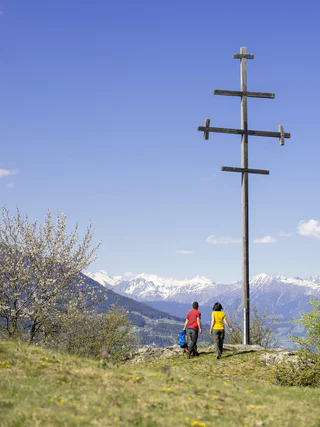
1/5
Wasserbühel Circuit trail
Albion/Albions, Lajen/Laion, Dolomites Region Val Gardena
In Zuid-Tirol zijn er plaatsen en locaties die een bijzondere energie uitstralen. Luister goed naar jezelf in de stilte van het bos, op de hoge uitzichtpunten of achter kloostermuren, en vind hernieuwde energie.

1/5
Albion/Albions, Lajen/Laion, Dolomites Region Val Gardena

1/3
Pietrarossa/Rotwand, Ritten/Renon, Bolzano/Bozen and environs

1/11
Cologna/Glaning, Jenesien/San Genesio Atesino, Bolzano/Bozen and environs

1/6
Caldaro Paese/Kaltern Dorf, Kaltern an der Weinstraße/Caldaro sulla Strada del Vino, Alto Adige Wine Road

1/2
Penone/Penon, Kurtatsch an der Weinstraße/Cortaccia sulla Strada del Vino, Alto Adige Wine Road

1/3
Prati/Auen, Sarntal/Sarentino, Meran/Merano and environs

1/3
Naturno/Naturns, Naturns/Naturno, Meran/Merano and environs

Dobbiaco Nuova/Neutoblach, Toblach/Dobbiaco, Dolomites Region 3 Zinnen

1/2
Plars di Mezzo/Mitterplars, Algund/Lagundo, Meran/Merano and environs

1/6
Colma/Kollmann, Barbian/Barbiano, Brixen/Bressanone and environs

1/5
Burgusio/Burgeis, Mals/Malles, Vinschgau/Val Venosta

Aquaviva/Ackpfeif, Lana, Meran/Merano and environs

1/5
Siusi/Seis, Kastelruth/Castelrotto, Dolomites Region Seiser Alm

1/11
Tablà/Tabland - Parcines/Partschins, Partschins/Parcines, Meran/Merano and environs

1/3
Trafoi/Trafoi, Stilfs/Stelvio, Vinschgau/Val Venosta

Varna/Vahrn, Vahrn/Varna, Brixen/Bressanone and environs

1/2
Braies di Fuori/Ausserprags, Prags/Braies, Dolomites Region 3 Zinnen

1/5
Santa Caterina/St. Kathrein, Hafling/Avelengo, Meran/Merano and environs

1/2
Stanghe/Stange, Ratschings/Racines, Sterzing/Vipiteno and environs

1/4
Casere/Kasern, Prettau/Predoi, Ahrntal/Valle Aurina

1/5
Colma/Kollmann, Barbian/Barbiano, Brixen/Bressanone and environs

1/4
Meltina/Mölten, Mölten/Meltina, Bolzano/Bozen and environs

1/6
Castelvecchio/Altenburg, Kaltern an der Weinstraße/Caldaro sulla Strada del Vino, Alto Adige Wine Road

Siusi/Seis, Kastelruth/Castelrotto, Dolomites Region Seiser Alm

1/6
Certosa/Karthaus, Schnals/Senales, Vinschgau/Val Venosta

1/5
Stanghe/Stange, Ratschings/Racines, Sterzing/Vipiteno and environs

Tiso/Teis, Villnöss/Funes, Dolomites Region Villnösstal

1/7
Ortisei/Urtijëi/St. Ulrich/Urtijëi, Urtijëi/Ortisei, Dolomites Region Val Gardena

1/4
Verano/Vöran, Vöran/Verano, Meran/Merano and environs

Santa Gertrude/St. Gertraud, Ulten/Ultimo, Meran/Merano and environs